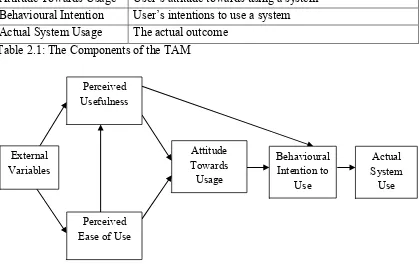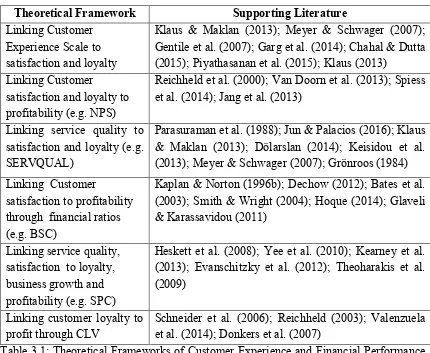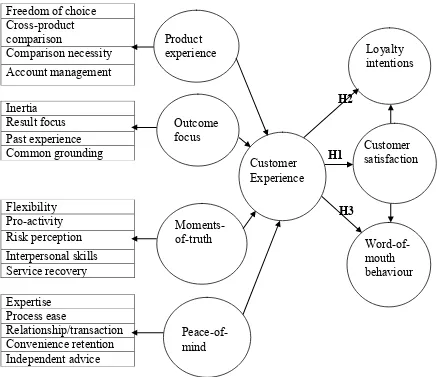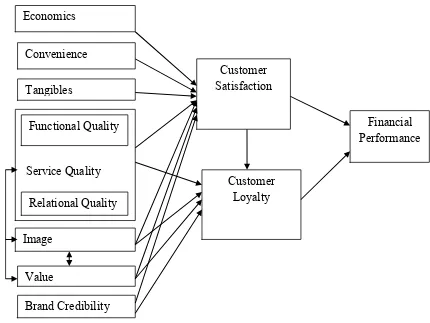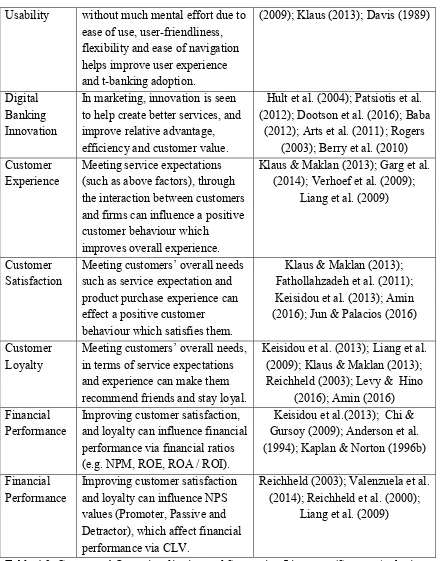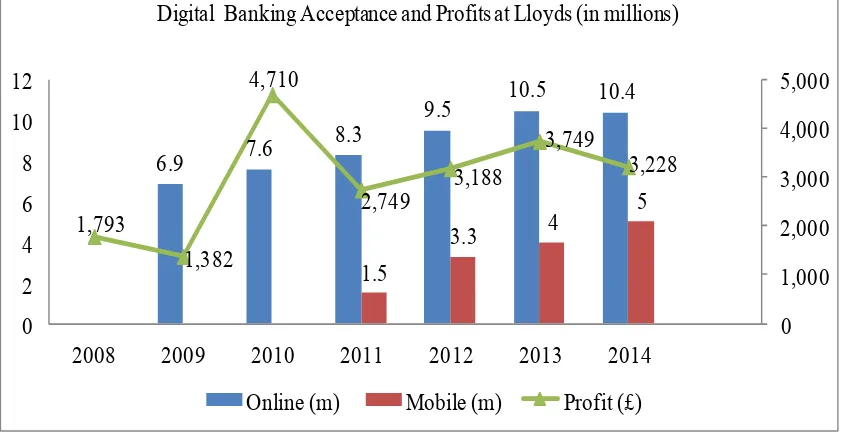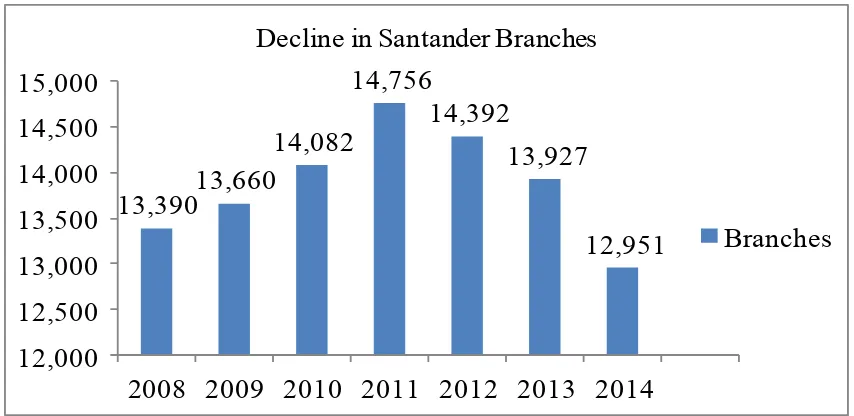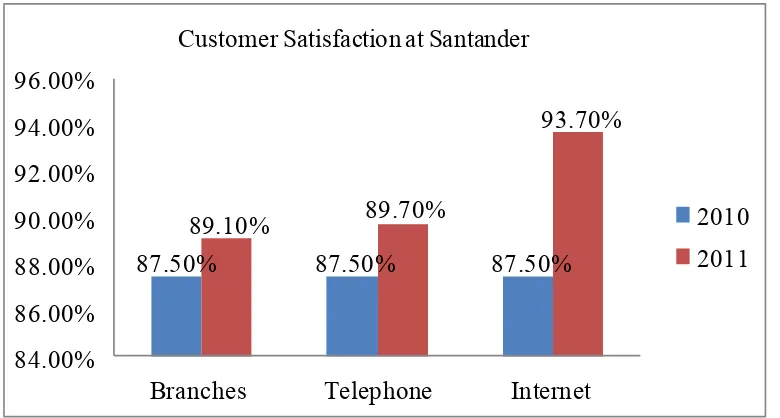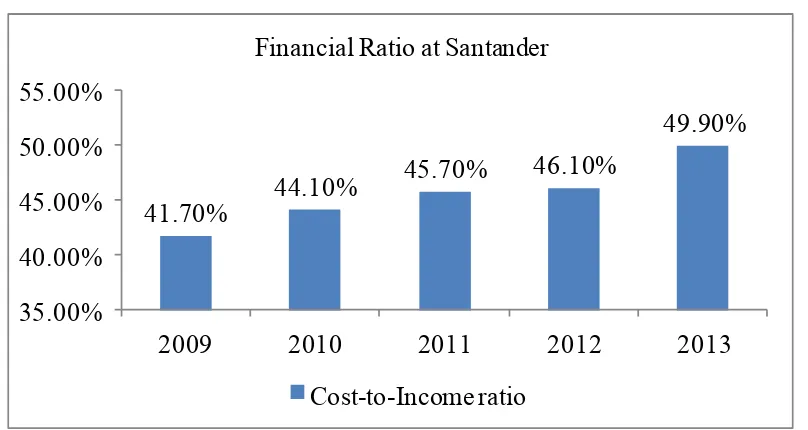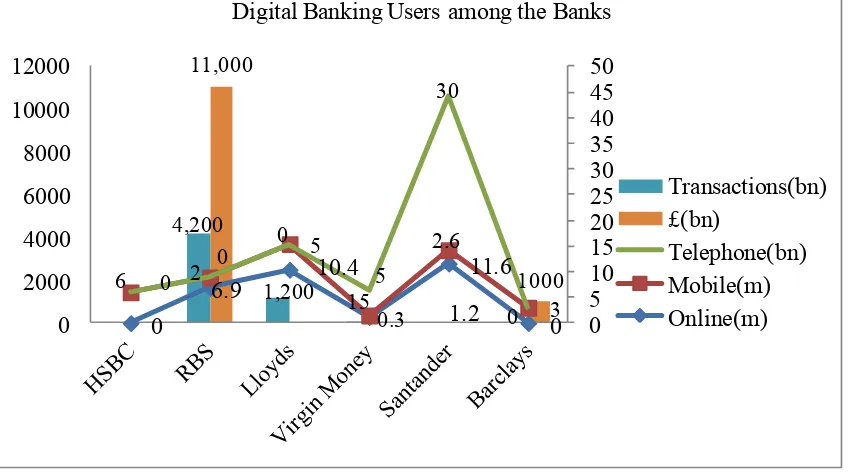Digital banking services, customer experience and
financial performance in UK banks
MBAMA, Cajetan
Available from Sheffield Hallam University Research Archive (SHURA) at: http://shura.shu.ac.uk/23305/
This document is the author deposited version. You are advised to consult the publisher's version if you wish to cite from it.
Published version
MBAMA, Cajetan (2018). Digital banking services, customer experience and financial performance in UK banks. Doctoral, Sheffield Hallam University.
Copyright and re-use policy
See http://shura.shu.ac.uk/information.html
Digital Banking Services, Customer
Experience and Financial
Performance in UK Banks
Cajetan Ikechukwu Mbama
A thesis submitted in partial fulfilment of the requirements of
Sheffield Hallam University
for the degree of Doctor of Philosophy
i
DECLARATION
While registered as a candidate for the degree of Doctor of Philosophy, the author has not been registered for any other award with any other university or institution.
ii
Digital Banking Services, Customer Experience and
Financial Performance in UK Banks
Cajetan Ikechukwu Mbama
ABSTRACT
Digital banking through telephone, internet and mobile is becoming important for banks’ service marketing, especially with the increase in digital device usage and customer demand for financial services. The changing dynamics of banking means that banks’ performance is no longer solely dependent on branch sales. Capturing and retaining customers are vital for banks, and digital banking is becoming the tool of choice; however research on how it affects customer experience and UK banks’ performance is still limited. This thesis focusses on determining the impact of digital banking services on customer experience and financial performance.
The research in the thesis uses a mixed methods approach, utilising bank financial reports, interviews and questionnaires to achieve important results and contribute to knowledge in practice, and in related services, marketing and e-commerce theories. The research adopted Regression, Structural Equation Modelling and Chi-Square analyses in quantitative research, while using Content Analysis in qualitative research. The research takes a broad approach in the investigation of digital banking, customer experience and bank financial performance. It has used qualitative and quantitative analysis techniques to produce, test and triangulate results to increase robustness.
iii
ACKNOWLEDGEMENTS
The research in the thesis has been carried out under the guidance of Dr. Lyuba Alboul, Dr. Martin Beer and Dr. Patrick Ezepue (former Director of Studies), Senior Research Fellows at the department of Arts, Computing, Engineering and Sciences. This work would not have been possible without the support rendered to me during the course of the research. Therefore, I would like to thank these supervisors for their advice and guidance throughout the research project, which contributed immensely to the research quality and my own development.
I would like to show appreciation to others who have been instrumental in the success of this research: the MERI administrators for their prompt response to information requests and helping distribute my questionnaires to Sheffield Hallam University students and tutors. I wish to thank my work colleagues, social media contacts, and the University students and tutors, who helped to fill in the research questionnaire. Without their cooperation and support the important findings in the study would not have been possible. My special thanks go to the case bank for supporting and allowing me to use their resource, and its senior managers, who have helped in the interview data gathering. They have shown great support, and without them the evaluation of this research would not have happened. I also want to acknowledge other banks whose information was used, which made it possible to generate a lot of new knowledge.
iv
GLOSSARY
Anova Analysis of Variance
B Unstandardised Regression Coefficient BBA British Bankers’ Association
BOE Bank of England BSC Balanced Scorecard
CEM Customer Experience Management CFs Conceptual Framework (s)
CFA Confirmatory Factor Analysis CLV Customer Lifetime Value
CMA Competition and Markets Authority CRM Customer Relationship Management CsTK Contribution (s) To Knowledge DB Digital Banking
DBSs Digital Banking Service (s)
DiBCEFPEF Digital Banking, Customer Experience and
Financial Performance Enhancement Framework e-banking Electronic or Internet banking
EFA Exploratory Factors Analysis EMP Employees in the Interview FCA Financial Conduct Authority FP Financial Performance GQM Goal Question Metrics
H Hypothesis
HSBC Hongkong and Shanghai Banking Corporation ICA Individual Current Account
v NPS Net Promoter Score OFCOM Office of Communications PCA Principal Component Analysis PEU Perceived Ease of Use
PhD Doctor of Philosophy
PRA Prudential Regulation Authority PRQ Principal Research Question
PU Perceived Usefulness r Correlation Coefficient
R Regression Coefficient
R2 Regression Squared Coefficient
R&D Research and Development RBS Royal Bank of Scotland ROA Return on Asset ROE Return on Equity
ROI Return on Investment
RQs Research Question (s) SD Standard Deviation
SEM Structural Equation Model SHU Sheffield Hallam University SPC Service Profit Chain
SPSS Statistical Package for the Social Sciences
s
ri2 Semi-Partial (Part) CorrelationsTAM Technology Acceptance Model t-banking Telephone Banking
TQM Total Quality Management TVE Total Variance Explained UK United Kingdom
t Student t Statistic α Cronbach’s Coefficient
vi
TABLE OF CONTENTS
Title
Declaration i
Abstract ii
Acknowledgements iii
Glossary iv
Table of Contents vi
List of Figures xi
List of Tables xiii
Chapter One: Introduction
1.1 Overview 1
1.2 UK Banking Setting 2
1.2.1 Contextualising UK Banking Sector 3
1.3 Rationale for Research 4
1.4 Background of the Study 6
1.5 Research Questions and Objectives 7
1.6 Research Strategy 8
1.7 Research Outcomes 10
1.8 Organisation of the Thesis 11
Chapter Two: Literature Review on Digital Banking Services, Improving Customer Experience and Financial Performance
2.1 Introduction 14
2.2 Developing Digital Banking in the UK 14 2.3 Characteristics of Digital Banking Channels 16 2.4 Digital Banking Uptake among Banks and Customers 18
2.4.1 Measuring Uptake 20
2.4.2 Expanding Digital Banking Studies 23 2.5 Customer Experience and Financial Performance of Digital Banking 24 2.5.1 Measuring Customer Experience and Financial Performance 25 2.6 User Perception of Digital Banking Services 31 2.6.1 Towards Better User Perception 34
vii Chapter Three: Conceptual Frameworks
3.1 Introduction 37
3.2 Underpinnings of the Conceptual Frameworks 37
3.2.1 Customer Experience 38
3.2.2 Financial Performance 44
3.2.3 Digital Banking Services 51
3.3 Hierarchy of the Research Conceptual Frameworks 59 3.4 Linking Conceptual Frameworks to Research Questions 62 3.5 Components of Conceptual Frameworks Related to the Research Model 63
3.6 Choice of Conceptual Frameworks 68
3.7 Summary of Gaps in Knowledge from Literature Reviews and Conceptual
Frameworks 70
3.8 Summary of Conceptual Frameworks and link to Research Questions 72 3.9 Limitation of Conceptual Frameworks 72
3.10 Conclusion 73
Chapter Four: Research Design and Methodology
4.1 Introduction 74
4.2 Research Methodology 74
4.2.1 Mixed Methods 75
4.3 Research Philosophy 77
4.3.1 Philosophy, Ontology and Epistemology 78
4.4 Research Design 81
4.4.1 Interview Research 82
4.4.2 Questionnaires and Surveys Research 82
4.4.3 Analysing Qualitative Data 83
4.4.4 Content Analysisof Bank Financial Report and Interview 83
4.4.5 Data Gathering Strategy 86
4.5 Qualitative Research Design 87
4.5.1 Banks’ Financial Report 87
4.5.2 Case Bank Interview 89
4.5.3 Data Collection for Financial Report 90 4.5.4 Data Collection for Interview 90 4.5.5 Data Preparation and Financial Report Analysis 91 4.5.6 Data Preparation and Interview Analysis 91
viii
4.6.1 Questionnaire Survey and Sampling Design 92 4.6.2 Questionnaire Design Method 93 4.6.3 Questionnaire Data Collection Method 96 4.6.4 Questionnaire Administration and Data Preparation 98 4.6.5 Questionnaire Data Analysis Method 98 4.7 Triangulation Method for Integrated Framework 99
4.8 Conclusion 100
Chapter Five: Exploring Banks’ Perceptions of Digital Banking Services Innovation Effect on Customer Experience and Financial Performance
5.1 Introduction 101
5.2 Research Design 101
5.3 Data Analysis 101
5.4 Qualitative Results 102
5.5 Quantitative Results 116
5.5.1 Digital Banking Acceptance, Experience and Financial Performance 117 5.5.2 Trend on Customer Acceptance of Digital Banking 121 5.5.3 Content Results showing Frequency Distribution 124 5.5.4 Intercoder Reliability and Ranking Results 127 5.6 Exploring Relationships between the Results 127
5.7 Discussion and Implications 128
5.8 Conclusion 130
Chapter Six: Exploring Customers’ Perceptions of Digital Banking Services Effect on Customer Experience and Financial Performance
6.1 Introduction 132
6.2 Research Design 132
6.3 Proposed Model 133
6.4 Analysis and Results 134
6.4.1 Respondents’ Profile and Frequency Results 134 6.4.2 Descriptive Statistics Results 136 6.4.3 Frequency and Percentage Distributions of Key Responses 137 6.5 Exploratory Factor Analysis Results 139 6.5.1 Definition of Items and Content Validity 139 6.5.2 Unidimensionality, Reliability, Convergent and
ix
6.6 Correlation Analysis of the Factors 142 6.7 Testing Factors of Customer Experience and Digital Banking Uptake 144 6.7.1 Testing Customer Demographical Data 145 6.8 Testing Proposed Model using Regression Analysis 146 6.9 Testing Customer Experience Factors against Customer Demographics 153 6.10 Testing Proposed Model using Structural Equation Modelling 154 6.11 Qualitative Analysis Results of Open-Ended Questions 157 6.12 Discussion and Implications 163
6.13 Conclusion 166
Chapter Seven: Exploring Employees’ Perceptions of Digital Banking Services Innovation on Enhancing Customer Experience and Financial Performance
7.1 Introduction 169
7.2 Research Design 169
7.3 Data Analysis 169
7.4 Qualitative Results 170
7.5 Quantitative Results 191
7.6.1 Intercoder Reliability and Ranking Results 195 7.6.2 Digital Banking Rating Results 196 7.6 Exploring Interrelationships between the Results 196
7.7 Discussion and Implications 198
7.8 Conclusion 201
Chapter Eight: An Integrated Framework for Enhancing Digital Banking Services, Customer Experience and Bank Financial Performance
8.1 Introduction 203
8.2 Framework for Digital Banking Economic Value-Adds 204 8.2.1 Integrated Framework Perspectives 206 8.3 Constructing the Integrated Framework 207 8.4 Integrated Framework for Digital Banking, Customer Experience and
Financial Performance 210
8.5 Discussion and Implications 215
8.6 Conclusion 218
Chapter Nine: Conclusions and Recommendations
x
9.2 Relating Research Findings and Contributions to Knowledge 221 9.3 Main Research Results by Research Questions 226 9.4 Theoretical and Practical Implications and Contributions to Knowledge 236 9.5 Suggestions and Implications for all Stakeholders 244
9.6 Limitations of the Research 248
9.7 Suggestions for Future Work 249
9.8 Closing Remark 250
References
251Appendices
A. Research Hypotheses Development 280
B. Dimensions, Attributes and Definitions of Factor Items 283
C. Ideas Tournament 285
D. Template for Bank Employees’ Interview 297
E. Sample E-Mail Containing link to the Questionnaire 299
F. Questionnaire distributed to Bank Customers 300
G. Distribution of Respondents Answers to Questionnaire 304
H. Published Work and Articles 306
1) MBAMA, Cajetan, EZEPUE, Patrick (2018). Digital Banking, Customer Experience and Bank Financial Performance: UK Customers' Perceptions.
International Journal of Bank Marketing. Vol:36, Iss:2, pp.230-255 (Published) 2) MBAMA, Cajetan, EZEPUE, Patrick, ALBOUL, Lyuba and BEER, Martin (2018).
Digital Banking, Customer Experience and Financial Performance: UK Bank Managers’ Perceptions. Journal of Research in Interactive Marketing. (Accepted for Publication)
3) MBAMA, Cajetan, EZEPUE, Patrick and ALBOUL, Lyuba (2017). Modelling the Effect of Digital Banking Services on Customer Experience and Financial Performance in UK banks, presented at the MERI Research Symposium Proceedings.
4) MBAMA, Cajetan, EZEPUE, Patrick (2015). Digital Services Innovation, Customer Experience and Bank Financial Performance, presented at the
xi
List of Figures
Figure 2.1: Online Banking Model (Source: Pikkarainen et al., 2004) 20 Figure 2.2: E-banking Model (Source: Lee, 2009) 22 Figure 2.3: M-banking Model (Source: Luarn & Lin, 2005) 22 Figure 2.4: Service Profit Chain (Source: Heskett et al., 2008) 25 Figure 2.5: Balanced Scorecard (Source: Kaplan & Norton, 1996a; 1996b) 29 Figure 2.6: The Links in SPC as tested (Source: Yee et al., 2010) 31 Figure 2.7: Technology Acceptance Model (Source: Davis, 1989;
Davis et al., 1989) 32
Figure 3.1: Customer Experience Quality (Source: Klaus & Maklan, 2013) 42 Figure 3.2: Measures of Financial Performance (Source: Capon et al., 1990) 46 Figure 3.3: Organisational Performance (Source: Venkatraman &
Ramanujam, 1986) 47
Figure 3.4: Information System Model (Source: DeLone & McLean, 2003) 52 Figure 3.5: Online Banking Satisfaction Model (Source: Yoon, 2010) 52 Figure 3.6: Services and Financial Performance Model (Source:
Keisidou et al., 2013) 55 Figure 3.7: Key Theoretical Frameworks of Digital Banking (Source: Author) 58 Figure 3.8: Strategic Map for developing DiBCEFPEF (Source: Author) 64 Figure 3.9: Conceptual Framework for DiBCEFPEF (Source: Author) 66 Figure 3.10: Customer Experience Model (Source: Garg et al., 2014) 69 Figure 5.1: Lloyds Digital Banking Acceptance Trend and Profitability 117 Figure 5.2: Santander Branches over the Years 118 Figure 5.3: Santander Customer Satisfaction at different Channels 119 Figure 5.4: Presents Santander Efficiency Ratios 120 Figure 5.5: Barclays Personal and Corporate Banking Revenue 121 Figure 5.6: Digital Banking users among Banks 122 Figure 5.7: Santander Cost Saving on Services and Enquires 123 Figure 5.8: Most Frequently used Words in the Financial Report 124 Figure 5.9: Frequency Occurrence of Units in Categories 125 Figure 5.10: Model showing the Relationship between the Report Themes 127
Figure 6.1: Proposed Model 134
xii
Figure 6.3: Bar Chart of Digital Banking Usage and Frequency 138 Figure 6.4: Bar Chart of Digital Banking Acceptance Trend 138 Figure 6.5: Bar Chart of Digital Banking versus Savings 139 Figure 6.6: Banks NPS and Frequency of Digital Banking Usage 146 Figure 6.7: Regression Plot of Customer Experience 150 Figure 6.8: Model of the Factors using Financial Performance (FP1) 155 Figure 6.9: Model of the Factors using Financial Performance (FP2) 155 Figure 7.1: Most Frequently used Words in the Interview 192 Figure 7.2: Frequency Occurrence of Units from the Themes 193 Figure 7.3: NPS Rating from the Interviewees 196 Figure 7.4: Model showing the Relationship between the Interview Themes 197 Figure 8.1: Digital Banking Services Research Perspectives 206 Figure 8.2: Initial Framework of Digital Banking Services (Source: Author) 208 Figure 8.3: Digital Banking Strategic Management Model (Source: Author) 209 Figure 8.4: Strategic Map for Integrated Digital Banking, Customer
Experience and Financial Performance Enhancement Framework (DiBCEFPEF) (Source: Author) 211 Figure 8.5: Integrated Digital Banking, Customer Experience and Financial
xiii
List of Tables
Table 1: Research Questions and Objectives 8 Table 2.1: The Components of the TAM 32 Table 3.1: Theoretical Frameworks of Customer Experience and Financial
Performance (Source: Author) 40 Table 3.2: Organisational Performance Measurement (Source: Hult et al., 2008) 49 Table 3.3: Key Theoretical Frameworks of Financial Performance
(Source: Author) 50
Table 3.4: Research in Digital Banking (Source: Author) 53 Table 3.5: The Hierarchy of Conceptual Frameworks of the Research
(Source: Author) 61 Table 3.6: Linking the CFs to the Research Questions (Source: Author) 63 Table 3.7: Research Model Design Elements 67 Table 4.1: Revenue Generation of four largest UK Banks (Source: BBA, 2014) 88 Table 4.2: Themes used in Interviews 89
Table 4.3: Constructs’ Operationalisation and Supporting Literature
(Source: Author) 96
Table 4.4: Themes used in Questionnaire 97 Table 5.1: Lloyds Digital Banking Acceptance and Profitability 117 Table 5.2: Santander Branch Numbers 118 Table 5.3: Santander Customer Satisfaction at different Channels 119 Table 5.4: Santander Efficiency Ratios 120 Table 5.5: Barclays Personal and Corporate Banking Revenue 120 Table 5.6: Digital Banking Users among Banks 121 Table 5.7: Santander Cost Saving on Enquiries 123
Table 5.8: Key Words Ranking 124
xiv
Table 6.8: Regression Analysis of Customer Satisfaction and Experience 151 Table 6.9: Regression Analysis of Financial Performance FP1 and FP2 152 Table 6.10: ANOVA between Factors and Customer Data 153 Table 6.11: Model Fit for Financial Performance FP1 and FP2 154 Table 6.12: SEM Test Results for FP1 and FP2 156
Table 7.1: Key Words Ranking 192
Table 7.2: Coding Results from the Themes 193 Table 8.1: Triangulation Matrix of Results from Banks, Customers and
Employees 213
1
=========================================
CHAPTER ONE - INTRODUCTION
=========================================
1.1 Overview
The offer of services through digital banking (DB) has become important in the banking sector. The development of digital banking has significant implications for banks’ marketing efforts (Dootson, Peatson & Drennan, 2016), as it affects customer interfaces. Digital banking enables banks and their customers to benefit from financial services. However, the transformation towards digital banking due to changing customer behaviour presents a challenge to banks, particularly in the way services are offered. As customer expectations and bank competition increase, capturing and retaining customers and improving profitability become crucial after the financial crisis of 2008 (Monferrer-Tirado, Estrada-Guillén, Fandos-Roig, Moliner-Tena & Sánchez, 2016).
Traditionally, UK bank customers bought financial products through bank branches. The arrival of digital banking channels such as telephone (t-banking), internet (e-banking) and mobile (m-(e-banking) banking have changed the way customers obtain services, challenging traditional banking methods. Digital banking was born from an original concept of selling services via the telephone in the late 1980s by First Direct (First Direct, 2014). It has enabled banks to offer multi-channel services, altering the way they interact with customers (Payne, Peltier & Barger, 2017; Cortiñas, Chocarro & Villanueva, 2010), and made UK banks close branches deemed unprofitable due to customer numbers dwindling (BBC, 2016; French, Leyshon & Meek, 2013). These changes in banks have made research into digital banking very compelling.
2 1.2 UK Banking Setting
According to Heffernan (2005), banks are financial firms, offering loan and deposit products on the market and catering to the changing liquidity needs of their borrowers and depositors. Prior to UK banking reforms, a few specialised banks dominated financial services. The changes introduced through the Building Societies Act 1986 and Banking Act 1987 enabled new banking institutions to move into the financial market (UK Government, 1986a; 1987). With these changes, building societies and banks were allowed to carry out a versatile role to accommodate customer demand for services, leading to further expansion of financial markets. Presently, UK banks are involved in services ranging from retail, insurance, commercial and investment banking, and customers can interact via digital channels, and self-service terminals, branches and call centres. The major retail banks (e.g. Lloyds, Barclays and Santander) operate on the UK high street.
Banking regulation in the 1980s, including the Financial Services Act 1986, was designed to self-regulate (UK Government, 1986b), but the UK government decided in 2001 to create an ethical code of conduct to provide greater supervision of banks to protect customers (FSA, 2002). Standards of behaviour affect banks’ ability to achieve their aims and the code of conduct objectives set by the Financial Conduct Authority (FCA) (FCA, 2013a). The highest ethical standards generate significant benefits for banks, whilst unethical behaviour affects reputation, and attracts sanctions and fines (e.g. Payment Protection Insurance). Therefore, banks need to consider security and customer experience in digital banking, while creating value for shareholders.
3
experience and financial performance using digital banking which has changed the way customers perform banking transactions.
1.2.1 Contextualising UK Banking Sector
The UK banking sector applies to financial institutions, from mutually owned building societies to the shareholder owned banks (Heffernan, 2005). The sector grew in the 19th century when London rose as a financial centre (Moutsianas & Kosmidou, 2016), now employing millions of people. It was transformed after the ‘Big Bang’ in 1986, when the London Stock Exchange was deregulated, allowing foreign ownership of member firms (Ekpu & Paloni, 2016), and Building Society and Banking Acts which enabled banks to carry out ‘one-stop’ financial services (UK Government, 1986a; 1987). These deregulations helped UK banks benefit from the globalisation forces and financial innovation, leading to additional liquidity, merger and acquisition, and financial market growth. They also created business opportunities for foreign banks, representing 55 percent of the UK banking sector’s assets, which account for a quarter of all European Union banking assets and were worth over £5 trillion in 2014 and 20 percent of the world’s cross-border lending (Ekpu & Paloni, 2016), highlighting its importance worldwide.
Currently, the five largest UK banks in terms of assets are Royal Bank of Scotland (RBS), Barclays, Hong Kong and Shanghai Banking Corporation (HSBC), Lloyds Group and Standard Chartered (BBC, 2013a). Although Standard Chartered is highly capitalised, it operates primarily in Asia and Africa. While Santander bank’s parent company is located in Spain, it features strongly on the UK high street, after taking over Abbey National, and Alliance and Leicester banks, and replaces Standard Chartered amongst the five UK largest retail banks (Competition & Markets Authority (CMA), 2015). There are other competing banks such as Virgin Money, Yorkshire, Tesco, Sainsbury, and more recently, post-financial crisis Atom and Metro banks have been established to challenge the dominance of the incumbent banks using digital banking.
4
2008). After the financial crisis, banks have sought to rebuild their balance sheets, improve their financial position, regain customers’ trust and improve customer experience and shareholder value. Notably, this study is conducted in the post-financial crisis period, which may have affected banks’ perceptions of financial performance and priorities, and customer demands, attitudes and experience about banking services. This research is necessary to highlight their perceptions after the financial crisis.
1.3 Rationale for Research
The relevance of digital banking services deployed over digital technology has become widely recognised. Changes in technological interfaces have enabled banks to delight customers with instant services through digital banking (Oliveira & Tam, 2017). The proliferation of ownership of digital devices like mobile phones, personal computers, tablets and laptops has spurred the demand for financial services on these devices. In recognition of the digital technology potential, the UK Government planned to connect all homes and businesses to the internet (OFCOM, 2009), opening up service opportunities, enabling banks to benefit from digital banking for service marketing. This means that banks can efficiently offer services, which customers can access through digital channels.
Many banks have struggled to make a profit after the 2008 financial crisis, forcing them to innovate and minimise costs. They have begun looking to gain from digital banking. Competition has motivated banks to embrace digital channels to automate operations and deliver better services (Alalwan, Dwivedi, Rana & Simintiras, 2016). Research in digital banking uptake argues that it offers banks alternative delivery channels through which services can be delivered more conveniently and economically (Akinci, Aksoy & Atilgan, 2003), and can be used to offer various services to customers (Koenig-Lewis, Palmer & Moll, 2010; Chong, Ooi, Lin & Tan, 2010).
5
effect of digital banking on customer experience, satisfaction, and loyalty, and how they contribute to financial performance critical for banks and an important research topic. The challenge for banks is how to meet these customer needs and make profit.
With rapid technological change, banks face the challenge of improving their customer experience and profit, following the financial uncertainty, increased FCA scrutiny and reduced customer confidence. Customers want high service quality, convenience and better experience via digital devices. However, studies into digital banking have put more emphasis on uptake (Martins, Oliveira & Popovic, 2014; Hanafizadeh, Behboudi, Koshksaray & Tabar, 2014; Chong et al., 2010), than on exploring customer experience, and the perceptions of banks and employees, who make decisions on how to offer services. Consequently, Hoehle, Scornavacca and Huff (2012) note that prior research has not identified all the issues involved in e-banking usage. Although digital banking is ubiquitous among mainstream banks, there is still a need to understand the impact on customer experience and bank financial performance, especially for different customer segments (Keisidou, Sarigiannidis, Maditinos & Thalassinos, 2013; Patsiotis, Hughes & Webber, 2012; Garg, Rahman & Qureshi, 2014). This will enable different banks to fine-tune their strategies in line with their overarching business model.
This research takes a holistic view, by looking at how banks and customers can derive value from digital banking. The research has reviewed literature on customer experience, satisfaction, loyalty and financial performance (Keisidou et al., 2013; Klaus & Maklan, 2013; Yee, Yeung & Cheng, 2010).It investigates bank financial reports, and employee and customer perspectives, to understand the links between digital banking services, improving customer experience and financial performance. This will help formulate a Digital Banking, Customer Experience and Financial Performance Enhancement Framework (DiBCEFPEF), comprising the above three perspectives. This new knowledge will provide better digital banking evaluation, helping customers and banks understand economic value-adds.
6
efficient framework. This will add new insight into their current banking model and marketing strategy, enabling banks to manage changing customer behaviour using digital banking. The research described in this thesis aims to investigate and contribute to knowledge through integrated frameworks for determining the effectiveness of digital banking services, related customer experience and banks’ financial performance.
1.4 Background of the Study
M-banking is an important strategic change to occur in banks in recent years (Oliveira & Tam, 2017). The role of digital banking in the transformation of banking services is having a significant effect in society. Teo, Anderson, Fenwick and Ying (2014) argue that businesses continuously exploit digital technologies to create new value sources and increase efficiency in customer services. Therefore, every business must transform into a digital business to survive. This suggests that banks should focus on digital banking aimed at improving customer experience, as customer needs are changing.
The internet has grown over the years, offering many applications as new ways for banks to meet customer demands and offer services (Martins et al., 2014). The effect of digital banking has been economically important, making it a strategic weapon to stay competitive, as banks face a challenging environment. The relevance of digital banking for providing services, has prompted researchers to concentrate in this research area (Jun & Palacios, 2016; Hanafizadeh et al., 2014; Xue, Hitt & Chen, 2011), as it is having a major effect on the way customers access financial services. However, Hoehle et al.’s (2012) study on digital banking utilisation states that prior research has limitations due to the study phenomenon and methods used. Therefore, this research will combine insights from a number of models and theories, including service quality, technology innovation and business performance to investigate the relationship between digital banking, improvement in customer experience and financial performance.
7 1.5 Research Questions and Objectives
The principal research question (PRQ) is:
PRQ: How can the research results be integrated into a framework for enhancing digital banking, related customer experience and bank financial performance, in light of such metrics as profitable growth and economic value-adds?
The principal research question is broken down into three additional questions:
RQ1: What are the banks’ general perceptions of digital banking services innovation in terms of customer experience and financial performance?
RQ2: How do digital banking services generally affect customer experience and bank financial performance?
RQ3: What are the employees' perceptions of digital banking innovation in the studied bank, and how effective is the bank's digital banking in enhancing customer experience and financial performance?
To address these research questions, the empirical research aims to analyse the effectiveness of digital banking with regard to customer experience and bank financial performance; it is expected that insights from these questions will yield an improved framework. Given the limited studies in the area, the findings will provide useful input into future studies.
The above research questions raise the following objectives:
Objective 1: To provide information on digital banking uptake, customer experience and financial performance through bank financial reports. It gives insight from banks and how they are serving customers with digital banking. Executives’ perceptions of digital banking innovation (RQ1).
Objective 2: To provide new insights into how bank customers are adapting to digital banking regarding uptake, perceived experience, satisfaction and loyalty, and impact on financial performance. Customers’ perceptions of digital banking (RQ2).
Objective 3: To provide insights into digital banking innovation, customer experience and financial performance, and evaluate areas that need more understanding from the case bank employees. Case bank employees’ opinions (RQ3).
8 Table 1 shows where the questions are addressed.
Research Questions Objectives Addressed in Chapter
RQ1 1 5
RQ2 2 6
RQ3 3 7
PRQ 4 8
Table 1: Research Questions and Objectives
This work is suitable for PhD research because of the depth of knowledge to be gathered to explain digital banking services and customer experience impact on financial performance, and the contribution to knowledge it will make for all stakeholders. The research will highlight best practices in digital banking, value-adds and how banks can adapt their business models to provide better services. The research insight will help UK banks’ management improve capabilities in their current digital banking strategies, by formulating appraisal and optimisation of position. It will help close the gap in banking services literature, providing new information on how to make digital banking more effective for banks and customers.
1.6 Research Strategy
There has been emphasis on a pedagogy of research modelling methods, which ensures that researchers have the right strategy and skills to solve real life problems, contribute practically to the targeted audience and build theory (Ezepue & Ojo, 2012). This approach is used to develop the research strategy. Robson (2002, p.80) describes a research design method as research purpose and questions, phenomenon to guide study, method of data collection and sampling strategy. Research purpose and questions are presented in this Chapter, while research theory and methods are addressed in Chapters Two to Four. The research results are presented in Chapters Five to Nine.
9
the two methods can be combined, and quantitative methods can be used to investigate qualitative data and vice-versa. For instance, it has become common practice in content analysis to use quantitative and qualitative methods to investigate data in a textual form (Vaismoradi, Turunen & Bondas, 2013; Hsieh & Shannon, 2005). The approach of using data from different sources increases validity, generalisability and ensures reliability of results, and is referred to as ‘triangulation’ (Creswell, 2003; Tashakkori & Teddlie, 2010; Duffy, 1987). This thesis uses quantitative and qualitative research methods to corroborate results.
The research study uses financial reports, questionnaire distributions from customers and interviews from employees of a UK bank. The research started by looking at literature for major attributes on uptake and experience of digital banking. It then obtained and analysed information from bank financial reports, looking for evidence of digital banking effects on customer experience and financial performance. It used evidence from the literature and analysis to construct questionnaires and interviews.
The empirical research in this thesis has not used a pure experimental design method, which involves the use of a controlled sample, manipulation of an independent variable and random allocation to groups or samples (Pedhazur & Schmelkin, 1991). Such an approach would have created ethical issues. The research has used reports, questionnaires and interview techniques popular in organisational, marketing and business research, and involves selecting respondents, asking questions, analysing data and drawing conclusions (Maxwell & Delaney, 2004, p.3). It is effective in science research where laboratory experiments are not ethically defensible (Robson, 2002, p.230). Bryman (1989, p.3) warns that a major issue in organisational research is access to information, therefore ethics and sensitivity of information should be considered.
10
an equal opportunity, and there was no bias in making choices. Every effort was made to maintain the research ethics and integrity stipulated and agreed with SHU and the case bank used.
1.7 Research Outcomes
As a result of the investigations described in this thesis a number of important conclusions can be drawn. There are three major digital banking channels, namely telephone, internet or online and mobile banking for offering value-added services, due to the perceived values they offer. There are other ways, point-of-sale, ATM and Contactless Card, however they are used for paying in and withdrawing money, and purchases. These channels have been shown to support service development in which mutual value between customers and banks is evident. They enable banks to innovate and differentiate themselves and provide unique products, helping them to stay competitive, and improve customer experience and financial performance.
The research has shown that banks can offer different services over digital banking channels (e.g. current account, standing order, savings, mortgage, insurance, credit card, transfers, payment and account enquiries). The limit to service marketing and value banks can derive depends on their ability to invest in Research and Development (R&D) and innovate in the digital banking services that set them apart from their competitors. It identified that customers and banks want value from digital banking, however, banks need to give value in terms of improving customer experience and satisfaction to gain value, regarding customer loyalty, economic value-adds and profitability. For this to happen effectively, digital banking attributes need to be designed with certain qualities in mind.
11
‘Customer Loyalty’, and improvement in ‘Customer Satisfaction’ enhances ‘Customer Loyalty’. These results were obtained by triangulating the three research viewpoints. The studies reported in this thesis have provided empirical support for the integrated framework previously described.
The research used three data focal points and identified that while many studies of bank financial performance use financial ratios, the results from customers and employees on using digital banking to improve customer experience, satisfaction and loyalty, and financial performance via Customer Lifetime Value (CLV) are quite revealing. The research evidence shows more closeness in the employee and customer views than in the financial reports, as they provided detailed information about the effectiveness of digital banking to deliver value. This will inform future direction in research. The importance of digital banking to banks and customers has been highlighted and recommendations made to stakeholders, especially in bank branch closures, security concerns and measuring customer experience and economic value-adds. Shortcomings with respect to the design of frameworks for enhancing digital banking experience and financial performance have been identified and recommendations given, to improve future research.
1.8 Organisation of the Thesis
The materials in this thesis have been organised into nine chapters. The empirical research involves three investigations, designed to address all the research questions.
Chapter One is the introduction. It provides a background of digital banking and UK banks, the study motivation and rationale, research questions and objectives, and important outcomes.
12
Chapter Three provides the research conceptual framework. It draws on further existing academic literature. It puts into context the current frameworks, models and theories for measuring digital banking, customer experience and financial performance, and new theoretical insights and knowledge this research stands to contribute. The hierarchical theoretical framework and available research methods were highlighted. The proposal and implications of a new integrated framework are discussed. It also shows how the research questions are derived.
Chapter Four introduces the research methodology and design. It presents the research methods used, and philosophical, ontological and epistemological background of the research. The research design details the data collection methods (financial report, interviews and questionnaires), and analysis techniques to show the impact of digital banking on customer experience and financial performance.
Chapter Five presents the results from content analysis of financial reports of six UK banks. It explores banks’ general opinions of digital banking innovation with regard to customer experience and financial performance. It answers RQ1.
Chapter Six presents results from questionnaires distributed to UK bank customers. It assesses the customers' opinions about their uptake, experience of and satisfaction with digital banking, to investigate the links between digital banking, perceived improvements in customer experience, and financial performance. It addresses RQ2.
Chapter Seven presents results from content analysis of employee interviews of a UK bank. It explores the case bank’s digital banking innovations, and investigates the effectiveness of digital banking in enhancing customer experience and financial performance. It answers RQ3.
13
14
=========================================
CHAPTER TWO – LITERATURE REVIEW ON
DIGITAL BANKING SERVICES, IMPROVING
CUSTOMER EXPERIENCE AND FINANCIAL
PERFORMANCE
=========================================
2.1 Introduction
This chapter presents the initial research theoretical background. A research theory is a logical framework capable of explaining phenomena (Lee & Greenley, 2008). Research models of interest utilising similar theories are: Service Profit Chain (SPC), SERVQUAL, Balanced Scorecard (BSC) and Technology Acceptance Model (TAM). The areas investigated are: assessing digital banking services effectiveness and uptake using current techniques with regard to service quality, customer experience, satisfaction and loyalty, and financial performance. The critical literature review identifies knowledge gaps and information on how the main research themes are linked, using extant articles and information.
The chapter starts with digital banking development in the UK. There is information on how digital banking is making services available, and the characteristics that make it attractive for offering multi-channel services. This is followed by a review of uptake among banks and customers, and identification of areas for further research. There is a critique of customer experience and financial performance measurement theories, and a demonstration of why new research is relevant. Finally, there is a review of models to support digital banking, measuring customers’ and bank employees’ perceptions. In each section reviewed, an indication of justification for further research is highlighted.
2.2 Developing Digital Banking in the UK
15
qualities (e.g. service and functional qualities, security (Amin, 2016; Jun & Palacios, 2016)), which need to be explored in the UK.
Digital banking created opportunities for banks to offer multi-channel services through telephone, internet and mobile. A firm is adopting a multi-channel strategy when its products get to market through two or more distribution channels (Payne et al., 2017; Coelho & Easingwood, 2008). Lee and Chung (2009, p.385) note: “The internet revolution, […], fundamentally changed the banking business sector in terms of the variety of financial services and how they are provided. […] mobile banking has become accepted as part of daily life.” Within the last decades, the availability of digital devices (e.g. computers, mobile phones, tablets and iPad) and their connectivity to the internet has resulted in customers looking to carry out financial services, rather than just e-mail, web browsing and making calls. This service offering via digital devices is increasing and competing with bank branches, however research in digital banking experience is limited.
The advent of digital technologies is making banks shift towards digital banking, which has simplified remote service access (Yousafzai, 2012). Research on e-banking uptake argues that it has had a major impact on the growth of banking services (Martins et al., 2014; Akinci et al., 2003). Similarly, Hoehle et al.’s (2012) study suggests that the proliferation of digital banking has impacted the way banks serve customers. Nevertheless, these studies are mainly on digital banking acceptance rather than the experience of it, which is a limitation. Self-service technologies have enabled banks to pursue an electronically mediated multi-channel strategy. Therefore, moving customers to e-channels is an important means of reducing operational costs. This is happening across e-commerce and internet related businesses (Piyathasanan, Mathies, Wetzels, Patterson & Ruyter, 2015), where many companies have grown quickly through marketing their products online rather than through traditional channels (e.g. advertising and word-of-mouth). For them, a digital channel offers a world marketing presence, however the service attributes that attract customers to banks need to be investigated.
16
Nowadays, customers expect similar levels of interaction in digital banking and social media. Banks can develop products, which customers can access conveniently from their devices. This convenience has precipitated the demand for services through digital devices. It also means that many customers are shifting towards digital banking channels. Consequently, the UK lost more than forty percent of its bank branches between 1989 and 2012 (BBC, 2013b; French et al., 2013). Stone and Laughlin (2016) notice that bank branch numbers are falling due to automation and advise collaborative marketing to avoid damaging customer experience and shareholder value. However, what makes a customer choose one bank’s digital banking over another still needs investigating, which will help in customer capture.
Research claims that more than six hundred bank branches have closed across the UK over the past year, with rural areas worst affected (BBC, 2016). The demand for branches is falling, as more people switch to e-banking, making some branches unprofitable. This scenario shows a glimpse of digital banking’s effect on existing bank models and customers. It coincides with Dootson et al.’s (2016) finding that perceived value draws customers towards services, which needs replicating in UK banks. This research suggests that banks should focus on digital banking to improve customer experience, save money and enhance financial performance. The development means that new bank models and ways of serving and maintaining customer relationships are required, hence making this research very compelling to fill the knowledge gap.
2.3 Characteristics of Digital Banking Channels
17
different customer interfaces (e.g. dial and browse methods), with telephone banking being offered first.
Digital banking studies have been fragmented, with researchers studying individual channels, which is a limitation. Amin (2016) and Raza et al. (2015) study e-banking service quality and its relationship with customer satisfaction and loyalty, while Jun and Palacios (2016) find m-banking service quality to affect customer satisfaction and loyalty in USA banks. Saleem, Zahra, Ahmad and Ismail (2016) note that social influence, market orientation and service quality relate to customer loyalty, with satisfaction as an antecedent. These studies offer advantages in certain contexts, however a comprehensive study is required to understand different views of digital banking for proper bank service marketing and theory building. Arguably, among the common things that should make digital banking appealing for customers are convenience, accessibility, service quality and value derived from them. This information will be investigated further.
The internet banking channel is classified as e-banking (Sarokolaei, Rahimipoor, Nadimi & Taheri, 2012), mobile banking as m-banking (Hanafizadeh et al., 2014; Lin, 2011) and telephone banking as t-banking (Sundarraj & Wu, 2005). These digital channels share many characteristics with other services, with the main difference being the transmission medium, which can either be mobile or internet digital networks in digital banking. Moreover, digital services are consumed as they are produced, intangible and cannot be kept in an inventory (Hatch, 1997). The interaction between banks and customers within the service delivery process can cause variations due to service quality (Amin, 2016). Undoubtedly, customers have different service expectations and how well service providers meet those expectations determines their satisfaction. Therefore, studies into what affects customer service expectations in digital banking concerning customer experience, satisfaction and loyalty are urgently required.
18
experience characteristics, as in this research. There are also studies aimed at increasing customers’ and banks’ economic values (Klaus & Maklan, 2013; Yee et al., 2010), which have not investigated digital banking.
Digital banking enables customers to perform transactions like paying bills, transferring funds and balance inquiries. It plays a central role in electronic payments to support e-commerce. Early digital banking was dominated by e-banking, but m-banking is beginning to challenge this dominance. In recent years, the proliferation of mobile phones has encouraged banks to provide m-banking applications (Jun & Palacios, 2016; Hoehle et al., 2012; Barnes & Corbitt, 2003), helping ensure their competitive survival. These characteristics of digital banking make it a strong alternative to bank branches, making it useful to study, thereby helping banks improve their understanding and capabilities. It can help banks to serve customers better, improve their experience, maintain relationships with customers and promote mutual benefit. The characteristics of digital banking make it pervasive, however customer experience could depend on the service and functional qualities (Monferrer-Tirado et al., 2016), and convenience (Keisidou et al., 2013), which need further investigation in UK banks.
2.4 Digital Banking Uptake among Banks and Customers
Competitive pressures are forcing banks to minimise costs and innovate, making digital banking an alternative way to provide services and prompting academics to explore its uptake. Similarly, customers are becoming more demanding, forcing firms to focus on service quality to enhance business performance (Pekovic & Rolland, 2016). There were early studies of the potential benefits and security aspects of digital banking, especially e-banking (Daniel, 1999; Black, Lockett, Winklhofer & McKechnie, 2002). Furthermore, Waite and Harrison (2002) study e-banking quality, focussing on identifying consumer expectations of websites. Howcroft, Hamilton and Hewer (2002) investigate the motives for and barriers to using e-banking and t-banking, and conclude that customers will continue to use bank branches, but eventually digital banking will replace them. Whilst digital banking has become a challenger to bank branches (Stone & Laughlin, 2016), it has not completely replaced them, and recent research has refocussed on digital banking qualities (Alalwan et al., 2016).
19
critical for banks (Shaha & Siddiqu, 2006). Martins et al. (2014) and Lee (2009) also argue that limited research has been done to find e-banking’s positive and resistance factors, even though it is a cost-efficient way of banking, while Maenpaa, Kale, Kuusela and Mesiranta (2008) advocate a shift in research towards e-banking experience. Subsequently, Piyathasanan et al. (2015) argue that few guidelines exist on how to improve customers’ internet experience, showing that further research is required.
Sarokolaei et al.’s (2012) study on the barriers to e-banking argues that reliability, security and customer satisfaction affect uptake, while recent research shows that brand in Israeli (Levy & Hino, 2016) and service quality in Saudi Arabian (Amin, 2016) banks, affect customer satisfaction and loyalty. This is not surprising as customer satisfaction has a financial effect on banks (Nagar & Rajan, 2005). The literature implies that further research attention should be focussed towards customer experience. This gap in research needs closing. As part of new knowledge, this research investigates security issues, brand, customer experience, satisfaction and employee perceptions of digital banking.
Some customers are reluctant to use e-banking due to perceived risk and trust (Martins et al., 2014; Kim, Tao, Shin & Kim, 2010). Featherman and Pavlou (2003) define perceived risk as the potential for loss in the pursuit of a desired outcome of using an e-service. They identify seven types of risk associated with e-banking: performance, financial, time, psychological, social, privacy and overall risks. Jun and Palacios’s (2016) recent study also finds security to be an issue for customers, while Wu (2011) investigates the location convenience effect on customer satisfaction. Thus, this research investigates perceived risks and trust further, and explores other digital banking risks to see if they affect customer experience.
20
shows that perceived usefulness, trust, and self-efficacy are predicting factors to use telebanking in Jordanian banks (Alalwan et al., 2016). This evidence shows that digital banking has evolved, however further research is required to give clear direction. Research should address the experience factors, which make customers choose one bank’s digital banking services over another, hence this research.
2.4.1 Measuring Uptake
Research suggests that e-banking can be a cost efficient delivery channel for services (Amin, 2016). Due to the interest in digital banking over the years, different uptake models have emerged. Harrison et al. (2014) survey Scottish bank customers and find that e-banking adoption depends on customers’ readiness factors like prior involvement and computer and internet experience, options and benefits awareness, and willingness to embrace change; and banks’ website readiness like convenience, perceived ease-of-use, security guarantee and channel costs. These are mediated by income, education and residential area. This means to improve customer experience digital banking must align with customers’ requirements, making banks’ and customers’ views important. Pikkarainen et al. (2004) also propose an e-banking model, presented in Figure 2.1.
Figure 2.1: Online Banking Model (Source: Pikkarainen et al., 2004)
The model shows that perceived usefulness, ease of use and enjoyment, information, security and privacy, and enjoyment of the internet are determinants of e-banking usage. Meanwhile, Amin (2016) and Raza et al. (2015) study e-banking service quality and its relationship with customer satisfaction and loyalty, an area that requires further attention. Other similar studies find that perceived usefulness, trust and government
Perceived Ease of Use
Perceived Enjoyment
Enjoyment of Internet Connection
Security and Privacy Information on Online Banking
Online Banking use
21
support influence online (Chong et al., 2010) and mobile (Deng, Deng & Zhang, 2010) banking uptake. M-banking is cost-effective for banks, convenient and easily accessible for customers (Zhou, 2012), while e-banking enables banks to develop flexible payment methods and user-friendly services (Cortiñas, 2010). However, previous digital banking studies have paid insufficient attention to employees’ perceptions and customer experience, and hence not fulfilled current bank service needs, which are among the research aims. Although prior research has implications for managers as customer needs are changing, satisfying customer requirements through digital banking experience is required.This research will fill the gap in knowledge.
Ozdemir and Trott (2009) find that e-banking adopters and non-adopters have different perceptions, experience and socioeconomic characteristics, based on perceived usefulness, ease of use and risk. They argue that European banks are facing competitive pressure following deregulation, and technology has become a strategic weapon to ensure profitability and develop banks’ market positions. Oblinger’s (2008) study recommends recognising different customer age groups with different needs, customer experience, requirements and technological aptitudes. Meanwhile, Cortiñas et al. (2010) find that the internet is changing banks’ interaction with different demographic groups, but do not find a relationship between age and multi-channel banking use. They find that customers are likely to conduct savings, transfers and mortgage transactions through digital channels, while Shanmugam, Wang, Bugshan and Hajli (2015) study e-banking adoption in UK banks and find that customers are satisfied, fund transfers and bill payment are the most popular services, with security being an issue of concern.
22
which is a limitation, and concludes that branch services should not be ignored. Lee’s (2009) model in Figure 2.2, explains factors affecting e-banking behaviour.
Figure 2.2: E-banking Model (Source: Lee, 2009)
Lee (2009) argues that e-banking has emerged as one of the most profitable ways of banking, while Luarn and Lin (2005) investigate the factors that can affect behavioural intention to accept m-banking and developed a model, illustrated in Figure 2.3.
Figure 2.3: M-banking Model (Source: Luarn & Lin, 2005)
Other major digital banking empirical studies focus on the factors influencing customer uptake (Hanafizadeh et al., 2014; Luo, Li, Zhang & Shim, 2010). However, Yousafzai (2012) reviews e-banking studies and concludes that they are still inconclusive. Early
Behavioural Intention Perceived Usefulness
Perceived Ease of Use
Attitude Towards use
Perceived Risks, e.g.
1. Performance
2. Social
3. Time
4. Financial
5. Security risk
Perceived Behavioural Control Subjective
Norm
Perceived Benefit
H4, 5 H2 H1,2,3,4,5
Perceived Credibility Perceived Usefulness Perceived Ease of Use
Perceived Financial Cost Perceived Self - efficacy
23
research centred on e-banking, but Schierz, Schilke and Wirtz’s (2010), and Jun and Palacios’ (2016) research shows that m-banking is receiving attention as an alternative way of banking. This corroborates other research that shows m-banking is increasing (Oliveira & Tam, 2017; Lin, 2011). Digital banking and customer needs are evolving; and research has struggled to create enough information to demonstrate a clear direction.
2.4.2 Expanding Digital Banking Studies
Waite and Harrison (2015), in a meta-analysis of a decade of e-banking studies, conclude that alternative research methods, theories and a wide range of data sources should be used, to push innovation boundaries. Hoehle et al. (2012) also synthesise three decades of study, and conclude that prior research has not identified all the issues involved in e-banking channel utilisation and may be limited due to fragmented findings and methods. These studies show that both early and recent research in digital banking has not solved all problems facing it. They suggest that previous studies have been faced with problems of customer usage, without balanced opinion, and banks need to make further efforts to win and retain customers, and grow business through digital banking. The limitation of existing studies justifies further research in digital banking experience, regarding service and functional qualities, which can help banks improve business. This research remedies the gap to widen digital banking knowledge.
Moreover, Oliveira and Von Hippel’s (2011) study on the user-innovators role in banking service find that users frequently develop and self-provide what they need before banks offer services to meet their needs. They conduct a study of the importance of customer service innovation, focussing on banking services, and find that between 1975-2010, banks were computerising their internal processes. However most services offered, from t-banking to payroll processing, are done to save money, and maintain accuracy and speed. The change created major opportunities to build new services, promoting innovative roles for both service providers and users, making it important for banks to consider their opinions. This study will extend research, which suggests employee and customer opinions, and engagement in digital innovation. It aims to contribute to digital banking in the new customer experience area.
24
demonstrated through implications, which is a limitation. The opinions of the bank executives who are responsible for investment are often not considered. Studies mentioned above show that customers and banks are accepting digital banking, therefore finding out what makes it effective, and improves customer experience and financial performance will add new knowledge to existing research. It is also important to look at digital banking from the external and internal perspectives: bank financial report, employee and customer. This will give a balanced approach to finding out if there is value for banks and customers. The research focusses on designing a framework, which will add new knowledge and hence extend the theories considered.
2.5 Customer Experience and Financial Performance of Digital Banking
Different theories for measuring customer satisfaction and financial performance have emerged like the SPC (Heskett, Jones, Loveman, Sasser & Schlesinger, 2008), SERVQUAL (Parasuraman, Zeithaml & Berry, 1988), Net Promoter Score (NPS) (Reichheld, 2003) and the BSC (Kaplan & Norton, 1996b). There is also the European Foundation for Quality Management (Doeleman, Have & Ahaus, 2014). These measures ensure that employee attributes, customer satisfaction and loyalty are measured, to understand whether they contribute to organisational profit. The SPC model establishes the relationships between service quality, employee satisfaction (employee retention and productivity), customer satisfaction and loyalty, and organisational performance (revenue growth and profitability). NPS gauges the customer satisfaction and loyalty of a firm, while SERVQUAL measures service qualities using reliability, tangibles, assurance, responsiveness and empathy without demonstrating their direct relationship to profitability, which is a limitation.
25
2.5.1 Measuring Customer Experience and Financial Performance
SPC and BSC highlight the importance of delivering high service quality to satisfy customers and enhance business performance. Unlike the BSC, the SPC and SERVQUAL were developed for the service industry. However, the BSC has been applied in banking service research, showing the veracity of the model (Glaveli & Karassavidou, 2011). Studies on the SPC model have been segmented, as researchers choose which components to study, validate and extend. For example, Kanyurhi and Akonkwa (2016) find a positive relationship between internal marketing and employee satisfaction, and a positive relationship between internal marketing and perceived organisational performance, but not between employee satisfaction and perceived organisational performance in Congo banks. Other empirical studies have linked service quality, customer satisfaction and loyalty (Amin, 2016; Klaus & Maklan, 2013), and profitable growth (Keisidou et al., 2013; Bates, Bates & Johnston, 2003), using SPC, represented in Figure 2.4, as a theoretical model.
Figure 2.4:Service Profit Chain (Source: Heskett et al., 2008)
Heskett et al.’s (2008) theory underpins a shift in the service sector by putting customers and employees first, altering how companies measure success. They argue that organisations emphasise how internal service quality, driven by the employee, can create external value for customers and shareholders, regarding customer satisfaction and profitable growth. This shows that customer satisfaction has a positive effect on customer loyalty, which drives profit. Keisidou et al. (2013) also study the links between service quality, customer satisfaction and loyalty, and financial performance.
Internal Service Quality Employee Satisfaction Employee
Retention External
Service Value Customer Satisfaction Customer Loyalty Employee Productivity Revenue Growth Profitab-ility
Workplace design
Job design
Employee selection and development
Employee reward
and recognition
26
However, these studies were not conducted in digital banking, which is a limitation. This research aims to investigate a framework that can help banks offer quality digital banking services, helping improve profitability.
Bates et al.’s (2003) study finds the linkage between good service experience and profit using SPC. Kearney et al. (2013) research employee and customer satisfaction, and profitable growth, and find there are links between them, providing evidence that there are financial benefits from providing a better service to customers. However, the link is still not clearly established in digital banking, where employee contact is minimal. Instead, employees need to know during design what customers expect from digital banking to bring satisfaction. Unlike contact services, the implications of contact with digital banking experience is unclear, hence the need for this research.
Early researchers focussed on relating customer satisfaction, loyalty and firms’ performance (Anderson, Fornell & Lehmann, 1994; Chi & Gursoy, 2009). Reichheld, Markey and Hopton (2000) quantify the potential for profit improvement resulting from increased customer loyalty, while service quality effects on customer satisfaction and loyalty have been established recently (Levy & Hino, 2016; Ladhari, Ladhari & Morales, 2011). However, many of these studies relate to contact services. Similarly, Parasuraman et al.’s (1988) SERVQUAL model measures customer service expectation and actual service received. Although this service quality framework and related models have had wider applications in services, digital banking requires a new framework, measuring at every touchpoint. For instance, customer priorities like courtesy and personal care could not influence loyalty with digital banking, which must have a good user interface quality (Lee & Chung, 2009; Yoon, 2010), be useful and easy to use (Lin, 2011). This means that existing models need extending to cater for digital banking experience and banks’ profit, hence this research.
27
in a franchise outlet. They find that managers of service outlets can strongly impact the satisfaction and purchase intentions of their customers. The physical environment of the organisation is important, but is irrelevant in digital banking.
Kearney et al. (2013), applying SPC, find that fifty percent of customer satisfaction is explained by service quality, and employee satisfaction and loyalty can be affected by the Servicescape. The link between customer satisfaction and purchase intentions is stronger when employees are satisfied. However, this link can vary depending on the service type (digital or non-digital) and delivery (contact or contactless) environment, not considered in previous studies. This reduces Servicescape theory in investigating digital banking. The SPC model has been criticised for being too generic to fully understand the drivers of business success, irrespective of environmental and operational context. It does not allow for industry-specific variables, such as firm size (Silvestro & Cross, 2000). With digital banking being a different kind of service, the SPC model and related types will need validation and extension.
The NPS links customer satisfaction to loyalty, and then to profitable growth, measured by subtracting the percentage of detractor from promoter customers (Reichheld, 2
